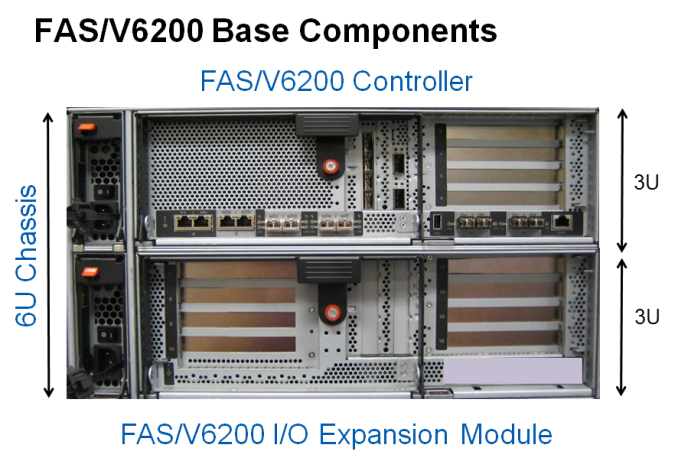The Impact of Disruptive Technologies on the Professional Storage Market
by Johan De Gelas on August 5, 2013 9:00 AM EST- Posted in
- IT Computing
- SSDs
- Enterprise
- Enterprise SSDs
NetApp: Flash Anywhere
Nutanix, CloudFounders/Amplidata, and Fusion-IO (covered on page eight) are clearly challenging the current market leaders NetApp and EMC. We decided to take a closer look at how the giants respond by looking at the latest products of NetApp. NetApp's first step with using flash memory was called “flash cache”. NetApp simply added a PCIe flash card and inserted it into its FAS V6200 storage arrays.
It was a quick way of adding some performance, but it was far from exploiting the true potential of NAND memory. First of all, the flash cache was only used for reads and secondly the cache used a very simple but hardly efficient FIFO eviction algorithm. Case studies (done by NetApp Customers) with applications with a typical read/write mix reported about 30% more IOPs and on average 20% lower response times when arrays with 10K RPM SAS disks where replaced by an array with a massive flash cache and slightly slower 7200 RPM disks.
Considering how large the gap is between flash memory and magnetic disks, and the small gap between 10K and 7.2K RPM disks, that is rather underwhelming. Part of the reason is of course that these arrays already have a healthy amount (4-8GB) of NVRAM (Non Volatile RAM) that caches the hottest data and makes writes more sequential. However, the list price of a flash cache module is anywhere between $16000 (256GB) and $50000 (1TB).
In a published benchmark, six FAS6240 with 192 15K RPM disks (costing $1.5 million in total!) achieved about 250k IOPs, or about 40K IOPs per array. To sum it up: it's a very high premium for an underwhelming but very welcome performance boost. Only customers who use read dominated applications (like warehouse / OLAP app) can really expect excellent performance.











60 Comments
View All Comments
Jammrock - Monday, August 5, 2013 - link
Great write up, Johan.The Fusion-IO ioDrive Octal was designed for the NSA. These babies are probably why they could spy on the entire Internet without ever running low on storage IO. Unsurprisingly that bit about the Octal being designed for the US government is no longer on their site :)
Seemone - Monday, August 5, 2013 - link
I find the lack of ZFS disturbing.Guspaz - Monday, August 5, 2013 - link
Yeah, you could probably get pretty far throwing a bunch of drives into a well configured ZFS box (striped raidz2/3? Mirrored stripes? Balance performance versus redundancy and take your pick) and throwing some enterprise SSDs in front of the array as SLOG and/or L2ARC drives.In fact, if you don't want to completely DIY, as many enterprises don't, there are companies selling enterprise solutions doing exactly this. Nexenta, for example (who also happen to be one of the lead developers behind modern opensource ZFS), sell enterprise software solutions for this. There are other companies that sell hardware solutions based on this and other software.
blak0137 - Monday, August 5, 2013 - link
Another option for this would be to go directly to Oracle with their ZFS Storage Appliances. This gives companies the very valuable benefit of having hardware and software support from the same entity. They also tend to undercut the entrenched storage vendors on price as well.davegraham - Tuesday, August 6, 2013 - link
*cough* it may be undercut on the front end but maintenance is a typical Oracle "grab you by the chestnuts" type thing.Frallan - Wednesday, August 7, 2013 - link
More like "grab you by the chestnuts - pull until they rips loose and shove em up where they don't belong" - type of thing...davegraham - Wednesday, August 7, 2013 - link
I was being nice. ;)equals42 - Saturday, August 17, 2013 - link
And perhaps lock you into Larry's platform so he can extract his tribute for Oracle software? I think I've paid for a week of vacation on Ellison's Hawaiian island.Everybody gets their money to appease shareholders somehow. Either maintenance, software, hardware or whatever.
Brutalizer - Monday, August 5, 2013 - link
Discs have grown bigger, but not faster. Also, they are not safer nor more resilient to data corruption. Large amounts of data will have data corruption. The more data, the more corruption. NetApp has some studies on this. You need new solutions that are designed from the ground up to combat data corruption. Research papers shows that ntfs, ext, etc and hardware raid are vulnerable to data corruption. Research papers also show that ZFS do protect against data corruption. You find all papers on wikipedia article on zfs, including papers from NetApp.Guspaz - Monday, August 5, 2013 - link
It's worth pointing out, though, that enterprise use of ZFS should always use ECC RAM and disk controllers that properly report when data has actually been written to the disk. For home use, neither are really required.